Abacusbio.co.nz
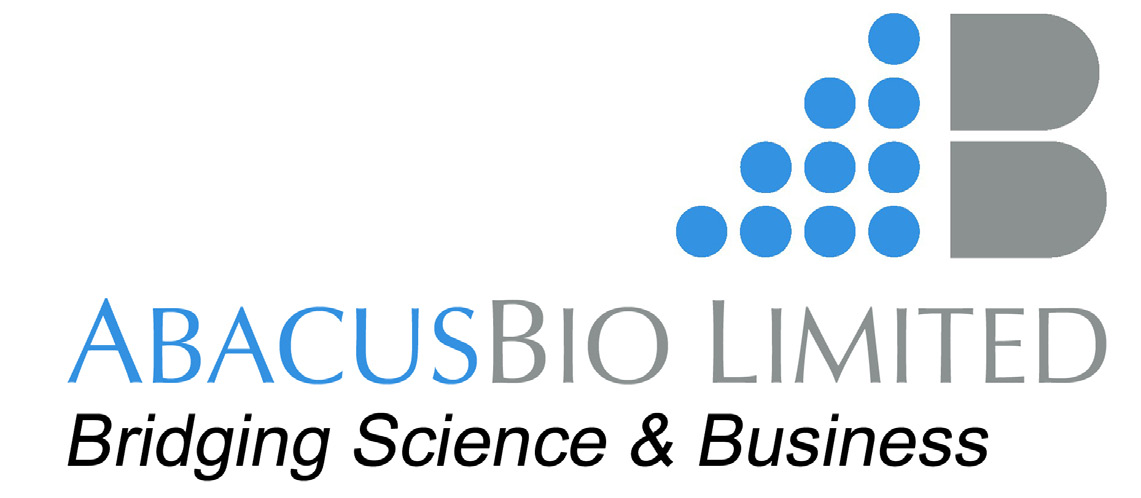
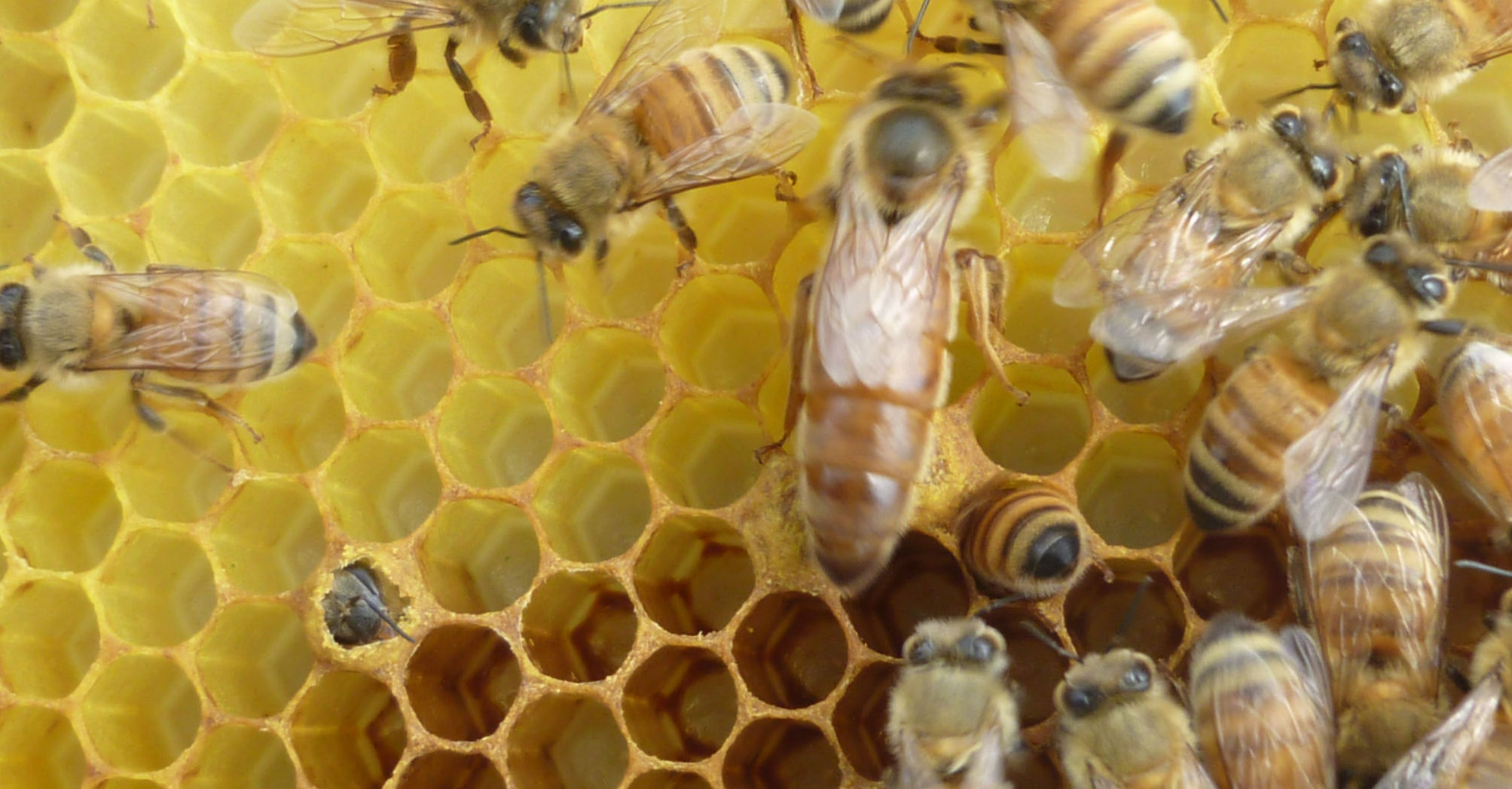

acusBio er Winter 2014
> In this issue <
• Updates for Alliance Group
• Partnering with European
experts could be key to
improving dairy cow fertility
• How can dairy farmers be
green without going red?
Photo source: Christine Moeller
Preparing for battle: breeding towards
disease resistance in honey bees
The infestation and reproduction of varroa mites within bee hives is killing bee larvae and increasing adult bees'
susceptibility to diseases. AbacusBio intern, Gertje Petersen supported Betta Bees in their quest to develop
breeding bees that are resistant to varroa.
Varroa mites infest bee hives and use
beekeepers to treat their hives with anti-
same type of statistical or mathematical
brood cells, where larval bees develop,
mite chemicals. Current research revolves
approaches that are used in New
as incubators to raise their own young.
around breeding for resistance to varroa.
Zealand for cattle and sheep breeding.
They attach to the bee larvae and adult
Betta Bees Research is a Dunedin-
bees, and suck their hemolymph (insect
based company owned by a number of
"Great progress has been made using
‘blood'). Apart from killing larvae and
beekeepers from around New Zealand.
a strict system of progeny testing, with
weakening adult bees, this process
They have been developing a strain of
focus on tolerance to the presence of
increases the bee's susceptibility to a
bees that detect the mite larvae in the
varroa in the hive", said Professor Kaspar
number of other diseases.
brood cell – the hygienic behaviour.
Bienefeld, Director of the Institute for
Bee Health in Berlin, where an effective
In order to deal with varroa, some bees
Gertje (who hails from Germany) has
breeding programme towards mite
have developed remarkable strategies,
been conducting research, capitalising
resistance has already been established.
known as hygienic behaviour, where the
on knowledge from around the world
worker bees open up infested brood
where there have been several attempts
Programmes like Betta Bees and the
cells and remove mites and dead larvae.
to establish populations of honey bees
German breeding programme, hold the
Some bees also groom other bees,
that are resistant to varroa. The baseline
key to improving New Zealand bees'
detaching and killing the mites in the
for ideas is selection for resistance in an
resistance to varroa mites – before they
existing population or cross-breeding
bring colonies to their knees – and
preserve the nation's honey supply.
Varroa is a relatively recent arrival in
with more resistant strains.
New Zealand. The feral bee population
"Germany is one country where there
has virtually disappeared in the face
is interesting work going on", Gertje
of varroa, resulting in the need for
said. The German researchers use the
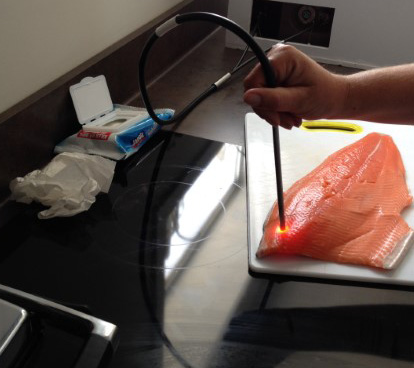
Interdisciplinary approach to reduce spinal
defects in Chinook (king) salmon
Overseas research (carried out on
king salmon. "The project has three main
programme, are involved in determining
different salmon species) has shown that
goals: to diagnose spinal deformities,
whether genetics play a role in the
environmental conditions, such as water
measure incidence and look at causes",
deformity issue by investigating whether
temperature during incubation, nutrition
Jon Bailey said.
deformities are an inherited trait.
at critical times, and genetics can all
play a part in causing spinal defects.
A diverse team with members from
Determination of whether there is a
Deformed fish increase production costs,
NZKS, NIWA, Massey University,
genetic relationship between deformities
have poorer performance, and cannot be
Skretting, Brightwater Consulting, and
and production traits is also carried
sold as a premium product.
AbacusBio was involved in the project –
out with the development of accurate
adopting an interdisciplinary approach
methods for detecting and diagnosing
Led by Jon Bailey from New Zealand
combining epidemiological, anatomic
changes in the spine. X-ray data from
King Salmon (NZKS), and Jane Symonds
and genetic data, including data on
two-year cohorts of family fish will
from National Institute of Water and
husbandry, nutrition and environmental
provide a platform to perform a genetic
Atmospheric Research (NIWA), the
conditions tested in replicated on-
parameter analysis on a range of
three-year project aims to determine
farm and tank based trials. AbacusBio
deformity traits.
the primary factors involved in the
consultants, Fiona Hely and Peter Amer,
development of spinal deformities in
in alliance with the NZKS breeding
NIR technology improves selection efficiency
for desirable consumer traits in salmon
AbacusBio and New Zealand
"The integration of NIR
King Salmon (NZKS) are working
and X-ray technologies
closely to incorporate technology
into trait recording for the
– in the form of Near Infra-Red
NZKS breeding programme
Spectroscopy (NIR) – into the
provides robust data
salmon breeding programme.
from which good genetic
Well known for its accuracy and
decisions can be made.
precision, NIR also saves time, money
Ultimately, it is about
and analytical resources when it comes
ensuring the salmon
to the annual trait recording of salmon
delivered to both domestic
breeding stock.
and overseas tables are of a
The NIR machine, bought earlier
consistently high standard"
this year, uses a spectrometer – that
measures light intensity as a function
of wavelength – to indirectly measure
NIR testing
crude fat in salmon fillets.
samples in two forms: one that involved
fat content, he found that the fat content
As part of the set-up, the machine
selecting 12 set points from a whole
could be accurately predicted from
was first calibrated using 120 salmon
fillet; and the other where fillets were
a subset of four points out of the 12
samples that were taken during harvest.
minced, homogenised, and selected at
measured on the whole fillet. This will
The fat was chemically measured, and
five points. It was found that sample
reduce the NIR sampling time for each
calibration equations were developed
homogenisation was an accurate
fish at next season's evaluation harvest.
for the NIR machine, where fat content is
method, but the fillet is wasted in the
Mark and AbacusBio consultant Fiona
predicted from the NIR spectral data.
process. Also, homogenisation is highly
Hely, will be attending the World
time consuming, with the need for
Chemical analysis is still the most
Aquaculture Society Conference in
equipment cleaning between sampling.
accurate at measuring total lipids,
Adelaide this year to identify other
Other concerns of this method include
however, it is relatively expensive and
technologies that can be used in
the possible introduction of unwanted
time consuming. NIR technology is rapid
advancing the genetic improvement
products (like water) during handling.
and low-cost, allowing fat content to
of New Zealand salmon. Fiona will also
become a routinely recorded trait for
AbacusBio consultant Mark Teviotdale,
be presenting an overview of NZKS's
was trained in the use of the NIR
selective breeding programme.
machine software and spectral output.
The team at NZKS led by Jon Bailey
Using the spectral data collected and
recorded NIR spectral data using salmon
calibrating against chemically measured
Breeding objectives for intensive dairy
feeding systems
A team of AbacusBio consultants,
led by Peter Amer, are working
together with DairyNZ and its
subsidiary New Zealand Animal
Evaluation Ltd (NZAEL) to optimise
genetic improvement in the
national dairy herd.
New Zealand dairy farms can be
classified into five production systems
based on the feeding practices adopted:
System 1All grass, self-contained; no supplement
feed purchased; no cows grazing off the
milking platform.
System 2Dry cow feed purchased; approximately
4-14% of total feed imported and fed to
Relative distribution of farms operating in different dairy production systems
dry cows, including those grazing off the
in New Zealand
milking platform.
System 3
Katarzyna Stachowicz, Peter Amer
The changes to economic
Dry cow feed purchased; approximately
and Tim Byrne are involved with,
values when applied to existing
10-20% of total feed imported for use at
revolves around understanding
breeding values have a modest
the platform to extend lactation (usually
the impact of developing and
impact on the rankings of bulls
autumn feed).
implementing specific breeding
within breeds and minimal
objectives for each of the varying
impact on relative breed
Dry cow feed purchased; approximately
The project objective is to formulate
There is evidence that differences
20-30% of total feed imported for use at
a potential selection index, targeting
between high and low milk yield
both ends of lactation.
intensive feeding system farms
genotypes for milk production
(i.e. breeding worth for high-input
traits are much greater for a high
systems) and predict its impact on
-input system than for a low-
Feed purchased for year-round feeding;
bull rankings, response to selection,
input system; this means that
at least 30% of total feed imported all
and predicted genetic progress for
high milk production genetic
year round including for dry cows.
traits included in the index.
merit cows are better able to
The initial phase of this project
reflect their genetic potential
There is variation in milk-solids
has been completed and the main
with better feeding, and this
production and profitability within
findings show that:
justifies a greater weighting on
each production system, according to
milk yield traits for high-input
DairyNZ studies. A farm can be profitable
Economic values for traits that
operating any of the systems. The best
are directly affected by feed
drivers of profitability are management
costs and reliant on grass
A number of aspects still remain to be
of milk-solids production and their costs
production tend to have higher
assessed, but there is potential that
within the production system.
weightings in intensive systems,
the more intensive feeding systems
reflecting the high impact of feed
would benefit from specific breeding
Currently, pastoral dairy production
costs, which must be coupled
objectives. The extent to which the
systems in New Zealand are intensifying.
with high milk production in
whole industry would benefit will be
The increased use of supplements
order to maintain profitability;
evaluated as part of a future study
and feeding-out has led to high-
focussing on deeper data analysis
input production systems which may
Economic values for milk
and a more complete understanding
eventually require specific management,
production traits in System 4 and
of the factors affecting genetic
resources and breeding policies.
5 herds were slightly different to
relationships among traits under
values obtained based on inputs
intensive pastoral production systems
One of the projects that AbacusBio
and assumptions relevant to the
and their genetic environment
consultants Bram Visser, Bruno Santos,
average intensity system herds;
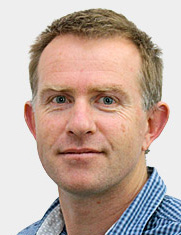
P tnering with European exper
tnering with Eur
ts could be
oving dair
y cow fertility
AbacusBio is working with DairyNZ to improve cow fertility through better genetic selection. AbacusBio consultant
Nicola Dennis travelled to Ireland, France and Switzerland to work on this with fertility and modelling experts.
In New Zealand's seasonal and pasture-
of the breeding worth evaluations (the
The AbacusBio team and their
based farming systems, most dairy cows
genetic ranking system used for dairy
collaborators will be building a computer
need to calve in early spring. Cows are
cattle) and is currently measured as the
model, simulating the genetic, farm
required to get in-calf during a finite
proportion of cows that calve within
management and environmental factors
mating season to meet their calving
the first 42 days of the calving system.
that influence cow fertility, in order to
deadline for the following spring. The
"This is a good start," Nicola explains,
tease out better ways to evaluate, and
earlier a cow gets back in-calf, the more
"but is a bit of a blunt instrument
ultimately speed up the rate of genetic
productive she is to the farmer.
because the calving rate is influenced
improvement in cow fertility.
Cow fertility is already an important part
by many management decisions and
environmental conditions".
Dairy diary: Are "cull" cows worthy of
Now that we have the cows into winter mode, it is a good time to reflect on the season past
and plan for the season ahead. Often we make decisions with minimal information during a
busy day. So now that you have a bit of time to ponder, while the cows have a holiday, think
about the question AbacusBio farm consultant Kevin Wilson has posed.
cost benefit analysis on the supplement
to fertility. Therefore, autumn and winter
(in table below), but also a question of
management of your herd will have a
whether that supplement would benefit
strong influence on seasonal production
the business through increasing body
and fertility. John Roche of DairyNZ
condition score (BCS) of the main herd
published that milk yield increases
Kevin Wilson
for the following season. If it is assumed
linearly with increasing calving BCS up to
The answer to this is not always
we need a margin over feed costs of $2
BCS 5. This would suggest that farmers
straightforward and will depend on
per cow/day to cover variable costs, and
need to focus on improving average BCS
pasture cover, supplements on hand, milk declining value of cull cows, then we
at dry off to help meet industry target
production, milk payment and setting up
would need to produce over 1.4kgMS/
BCS at calving. Cows calving at less
for the following season. Milk production
cow/day before there was a true
than BCS 5 will also have an extended
response to supplements will depend
monetary benefit from feeding silage to
postpartum anoestrus period, reduced
on how hungry the cow is. In situations
culls/empties at $7.00 pay out.
potential number of breeding events,
where cows would be underfed if not
reduced milk production and increased
supplemented (i.e. residuals less than
Based on the table below, there can be
vet and artificial insemination costs.
1600kgDM/ha), milk solids responses are
monetary gain from milking culls/empties
consistently 6g to 8g MS/MJ ME fed. With provided you are utilising pasture
As indicated, we can make gains from
good quality silage, this means you would and supplements offered, and that
feeding supplements to cull cows during
expect about 75gMS/kg supplement, or
milk production is at a sufficient level.
the autumn period, provided we do
However, there can be significant indirect
the basics well and are aware of the
benefits from culling these animals early
associated cost/benefit, but this should
This also raises the debate about when
(start of April). Studies from New Zealand
not occur at the expense of capturing
to ‘offload' empty and cull cows; are we
and overseas consistently show that BCS
the full indirect benefits for the following
better to milk them to the end or use
has an important role in influencing cow
that feed to set up cows for the following
reproduction, with BCS at calving being
season? This question is not simply a
the most important BCS measure relating
kg Silage
Supplement
Supplement
Margin with
Production
cost per cow/
no Lwt gain/
MJME eaten
Margin from feeding silage to cull cows gaining zero lwt/day at $7.00 pay out (based on 11 MJME/kg DM silage costing 38c/kgDM
and 80% utilisation)
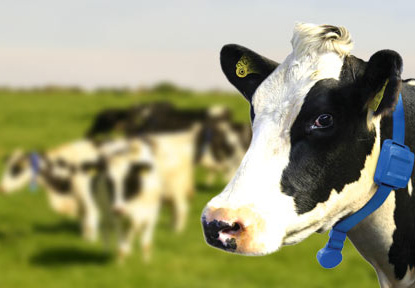
Review of dairy breeding objectives
The Australian Dairy Herd
In Australia, the selection index that helps there are differences in trait improvement
Improvement Scheme (ADHIS) is
farmers to make their decisions is the
priorities for different feeding and calving
reviewing the National Breeding
Australian Profit Ranking (APR).
systems, is one of the key outcomes of
the survey". Thirteen traits were included
Objective (NBO) in Australia's dairy
AbacusBio consultants are working with
in the survey, including production,
industry and in doing so, is working
ADHIS to gather views and priorities of
dairy farmers. During March and April,
health, and type traits.
with AbacusBio consultants Bruno
farmers from around Australia completed
As well as analysing the survey data,
Santos, Daniel Martin-Collado, Tim
a 1000Minds® survey that asked them
AbacusBio will be working with ADHIS
Byrne, and Peter Amer to determine how they select bulls, feed their cows and and Australian geneticists on economic
the best path for future progress.
what traits they regard as important.
analyses, to calculate economic values in
the NBO. The outcome of this work will
ADHIS is charged with maintaining
Michelle Axford, of ADHIS, said that
be that the NBO and final formulation of
the national database of performance
"understanding what traits farmers see
the associated selection index will rank
and pedigree records, and providing
as important for dairy cow performance,
cows and bulls to reflect the priorities
genetic evaluation and extension services
efficiency, and profitability will help guide
of Australian dairy farmers. Ultimately,
(amongst other things) for the Australian
further economic analysis and selection
breeding objectives and indexes set the
dairy industry. They are looking for
index development work".
direction of genetic improvement for
guidance from dairy farmers on what
Dairy farms in Australia have diverse
the industry. The formulation of the APR
makes a functional and profitable cow,
feeding systems and calving patterns,
will lead to more informed decisions and
suited for Australian production systems.
due in part to the variable climate within
increased profitability for Australian dairy
The NBO underpins the selection indexes
the states where dairy cows are farmed.
farmers in the future.
used to rank bulls and cows for breeding.
Michelle said that "establishing whether
Moving towards better efficiency in oestrus
detection and insemination timing in cows
There are currently four methods, with varying degrees of accuracy and automation for oestrus detection, which
remains a challenge for improving reproductive and economic efficiencies in dairy farms.
Accurate oestrus detection is vital
to the sacrum (top of tail) of the cow,
been shown from inseminating 11-16
for improving fertility rates in dairy
indicating if a cow has been mounted.
hours after the onset of active oestrus,
operations. AbacusBio consultants Renata Detection rates are reported to vary from
therefore, devices which can monitor the
Green and Bruno Santos review the latest
under 50% to over 85%. Devices vary
oestrus cycle in real time are more likely
technologies in this article:
from non-electronic (tail paint, EstroTect),
to result in higher conception rates.
to commercially available electronic radio
Visual detection is currently the most
frequency data communications, such as
Although visual detection is the
widely used mechanism for oestrus
the HeatWatch® system. The detection
predominant mechanism used for heat
detection on New Zealand dairy farms,
efficiency using electronic devices will
detection on NZ dairy farms, there is the
but is time consuming, and requires
be affected by the threshold set for
opportunity for an increased adoption of
diligent attention by staff to be accurate.
identifying oestrus, and the way the
more accurate and less labour intensive
Visual detection efficiency varies from
device is attached to the animal.
devices. Renata said, "these devices
will become more mainstream as the
Progesterone test (milk or blood
technology becomes more accurate and
Pedometry measures the number of
plasma). Recent advances in biosensor
reliable than visual detection".
steps taken by a cow in a given period,
technology, together with the advent
requiring real-time data transfer in order
of in-line automated milk sampling
to identify oestrus onset and accurate
and processing systems, make on-farm
insemination timing. Pedometer detection automated real-time monitoring of
rates are reported to vary between
reproductive status (using progesterone
80-100%, depending on the threshold
measures) a realistic proposition. The
used to define an increase in activity as
decrease in progesterone concentrations
an oestrus period, and the time period
in blood or milk is a very accurate
used to account for the number of steps.
predictor for heat detection, with
Furthermore, cow and environmental
experimental data showing 90%-95%
factors can affect efficiency of activity.
accuracy on a consistent basis. Studies
Mounted detection devices are attached with conception rates of 87% have
Photo source: Dairymaster NZ
Updates for Alliance Group hoofprint 3.0
AbacusBio has been working
with Alliance Group and
sheep and beef farmers to
add a new range of features
to hoofprint 3.0.
In addition to sheep and cattle,
Alliance Group suppliers can
now monitor the performance
of deer using hoofprint. New
features have been introduced
to the software to assist users
in tracking key performance
indicators, such as the number
and average weight of stock sold.
The latest additions are a deer
module that allows suppliers
An example of the hoofprint report interface showing total farm products generated in
to record venison and velvet
a range of sheep, cattle and deer farm enterprises between the 1 July 2013 and
data, and a ‘date picker' to allow
1 March 2014
comparison of growth rates and
farm products sold at any stage
throughout the year.
Changes have also been made
within the reporting menus,
allowing users to see the full
range of reports available on
each farm at a single glance.
Enhancements to the existing
reproduction, growth and
environmental outputs ensure
that when farm data are added,
additional reports become
available, allowing users to
compare what is happening on
their farm this year with the same
date in prior years.
Hoofprint has also been changed
An example of the sheep products report interface, allowing users to compare the
to allow users to run multiple
number of products sold off-farm, according to product type
enterprises. This is particularly
useful for producers who run
separate venison and velvet
herds, effectively allowing them
to manage separate lines of
animals. For example, users can
now get a stock reconciliation
and a full set of reports for their
beef breeding and store dairy
grazing herds, whilst deer farms
can separately record Red and
Elk/Wapiti herds. Another great feature is the
ability to reconcile stock numbers
at any stage throughout the year.
Stock reconciliation is often one
of the hardest things to do, with
users required to identify the
correct stock classes for all of
their Alliance Group transaction
data, as well as entering all of
their other livestock movements
The farm reports menu allows users to select from a range of deer key performance
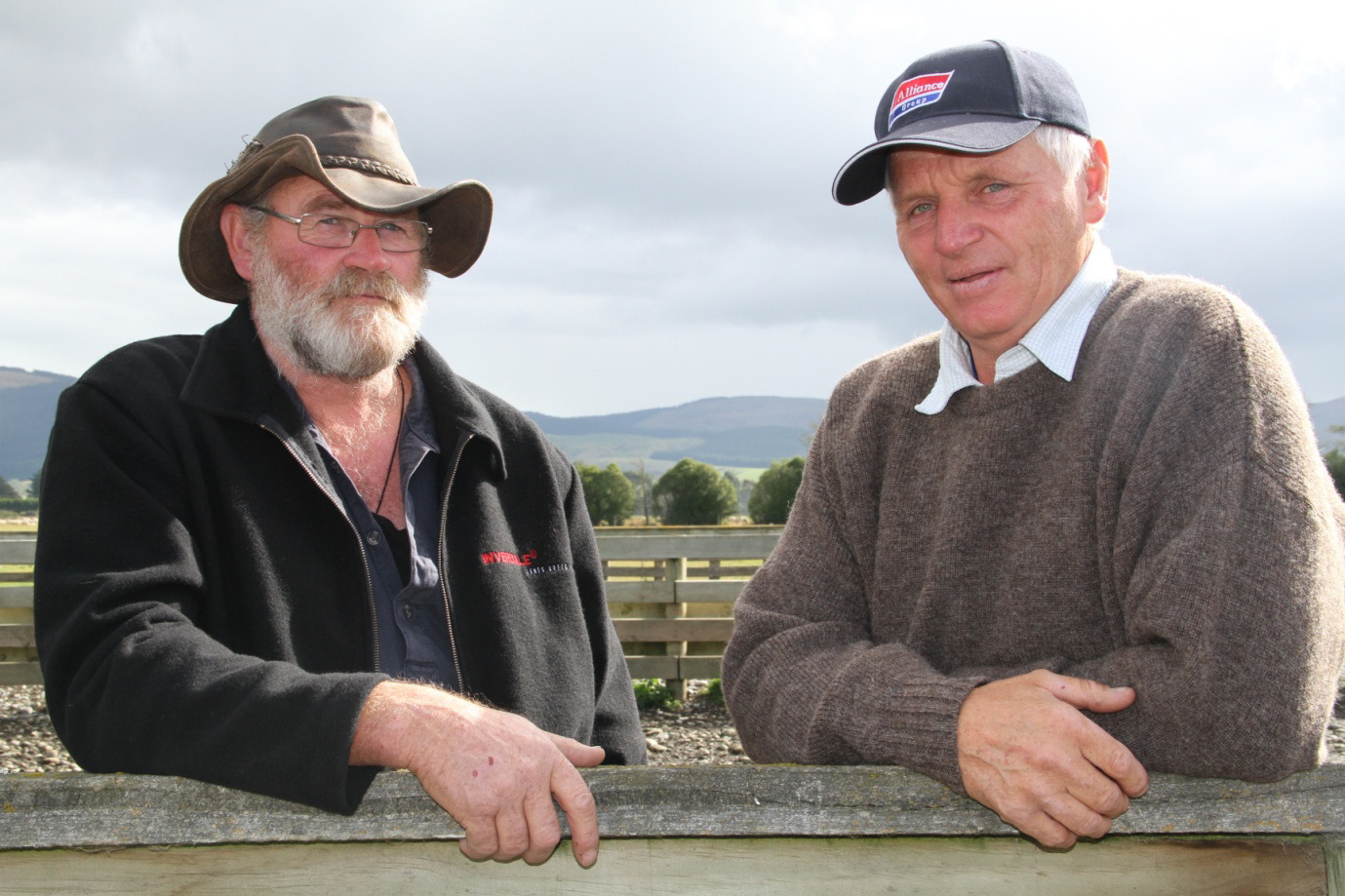
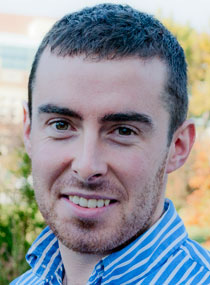
on and off farm, including
stores, grazing and home-kill.
By upgrading hoofprint to allow
stock reconciliations to be run
at any time throughout the year,
users can easily identify where any
issues are, and ensure that their
data are accurate and truly reflect
what has happened on-farm.
Future planned developments
will see the introduction of an
"auto-balance" option, where the
user will be able to select from a
range of options to resolve stock
reconciliation issues. The practical use of hoofprint was
demonstrated recently at the Beef
+ Lamb New Zealand field day
held at John and Mary Lindsay's
property at Dipton, focussing on
"early lamb finishing". Using the
carcase data collected by Alliance
Wakefield farm stock manager Lindsay Dawson, left, discusses lamb growth rates with
Group, hoofprint was used to
farm owner John Lindsay, right. Photo courtesy of Diane Bishop, The Southland Times
track the growth rates of all lambs
slaughtered in the 2012 and 2013
to a discussion around the potential for
"While the latest release is
seasons to date. Excellent early
additional reporting outputs to assist
season growth rates resulted in
mainly about deer, we have
suppliers in reviewing what is happening
some lambs being killed prior
added new features to the
to weaning, with growth rates
sheep and cattle modules
of up to 600 grams per day.
The Red Meat Profit Partnership initiative
as well. One of the most
The average growth rate of all
raises the question of how best to capture,
exciting features is the ‘date
2012 born lambs slaughtered
integrate and report farm data. Alliance
was around 280 grams per day.
Group hoofprint has taken a step in
picker' that allows users to
AbacusBio consultant Jude Sise
this direction, with both new and future
interrogate the system at any
demonstrated how average
developments focussing on collecting
given date throughout the
growth rates change throughout
and presenting farm data in a way that
the season using the hoofprint
is intuitive and able to assist suppliers in
date picker function. This led
evaluating farm business decisions.
Jude Sise
Canadian beef industry project with a
touch of kiwi
John Crowley, from the University of Alberta, visited AbacusBio in February and
March 2014 to conduct work pertinent to the Canadian beef industry.
Hailing from Ireland, John has been in
"There are three major challenges for beef
Canada for the past three years where
production in Canada compared to New
he works with Livestock Gentec, at the
Zealand," John said, "such as selection of
University of Alberta, as an Industry R&D
the right animals when there are hugely
Associate. Livestock Gentec is a research
varying environments within one country, a
centre that the university set up to carry
disjointed value chain, and sheer scale".
out and capitalise on world-class genomics
research and deliver solutions to industry
While these challenges exist, John was
delighted with his time at AbacusBio, and
goes back to Canada with real solutions
During his time at AbacusBio, John's
both elucidated from the specific tasks as
main focus was on developing economic
well as "chats over coffee". Ever the worker,
selection indices tailored to Canadian beef
John also managed to enjoy himself outside
John Crowley. Photo source:
production. He also investigated a couple
the workplace with trips to Queenstown and
Livestock Gentec
of side-lines such as trying to understand
mountain biking in Naseby. John is set to
the variation in sensitivity in selection for
return to Dunedin next February for ‘round
residual feed intake.
AbacusBio sponsors Polytechnic BIT Awards
As an international leader in agribusiness consulting –
well known for our agri-tech services – it is important
for AbacusBio to actively contribute to the IT sector.
This year, we are very proud to be the main sponsor
of the Otago Polytechnic IT awards, as part of our
continued commitment to students at the University of
Otago and Otago Polytechnic.
AbacusBio consultant Mark Teviotdale, was recently
a guest speaker at the 2013 graduating class of the
Bachelor of Information Technology. Mark (who
himself was a BIT graduate) also presented two new
AbacusBio-sponsored awards: Award for Best Student
in Programming in the BIT (awarded to Tim Miller), and
Award for Best Graduating Student in the BIT (awarded
to Logan Mabbett). Congratulations Logan and Tim!
(Top right) Tim Miller receiving his award from AbacusBio
Consultant Mark Teviotdale, for Best Student in
Programming in the Bachelor of Information Technology
(Bottom right) Logan Mabbett receiving his award from
AbacusBio Consultant Mark Teviotdale, for Best Graduating
Student in the Bachelor of Information Technology
Armidale animal breeding summer course
The 2014 annual genetics summer course saw
AbacusBio consultants Bram Visser, Bruno
Santos, and Daniel Martin-Collado travel to
Armidale, Australia – home of the University
of New England, one of the most prestigious
universities worldwide in the field of animal
breeding.
Organised by Professor Julius van der Werf and his team, the
one-week course aimed to introduce updates on the latest
developments in breeding programme design and genomic
selection. With over 40 attendants from all over the world, the
summer course also provided a platform for networking, and
learning about current issues and opportunities in different
countries.
The course was co-presented by Julius van der Werf and Dr
AbacusBio consultants Daniel Martin-Collado and Bruno
Jack Dekkers, Professor of Animal Science from Iowa State
Santos enjoying the view of the Dangars Falls
University. Dr Dekkers is a world leading expert in utilising
molecular and genomic information to enhance animal
fields of breeding and genetics: Rob Banks (Meat and Livestock
breeding, a topic that was a large and interesting part of the
Australia), Andrew Swan (Animal Genetics and Breeding Unit),
and Alison van Eenennaam (University of California Davis).
Bruno said that "it was a privilege to hear from two of the
Of course there was time for some well-deserved relaxation
leading scientists in the field of animal breeding, who are
after days of intensive studying. Here Daniel (left) and Bruno
also very skilled and passionate teachers". The course also
(right) are standing in front of the 120 meter Dangars Falls.
included presentations from invited guests working in various
Note the lack of water; it had not rained for almost a year!
How can dairy farmers be green without
going red?
How do our southern South Island dairy farmers reduce their impact on the environment while continually
improving production and profit? This is one of many questions being addressed by the DairyNZ Southern
Wintering System programme (SWS).
AbacusBio consultants, Jo Kerslake and
stall barn; loose-housed barn;
Kevin Wilson are working with lead
wintering pads and crop-based
scientists, Drs Dawn Dalley and Ina
wintering. Initial on-farm visits
Pinxterhuis of DairyNZ and Miranda
were undertaken to understand
Hunter of Roslin Consultancy Ltd, to
farm goals and objectives, and
understand how wintering is managed
collect farm system data required to
in the southern region. They aim to
develop the model in Farmax Dairy
review how different management
Pro® and Overseer®. The personal
approaches can improve farmers'
goals and objectives of each farmer,
production and profit outcomes, as well
a description of their current farm
as their environmental impact.
system, and its impacts, were
"With the current drive from the dairy
presented at the SWS Community
sector to be more competitive and
of Practice. Strengths and
environmentally responsible, it is vital
weaknesses, and latest research
that scientists, consultants and farmers
findings were then discussed,
Photo source: DairyNZ
work together to explore various
resulting in the development of three
running since 2010. More information
wintering system approaches that not
to four alternative management
only reduce the environmental impact,
approaches for modelling. Developing
but are cost effective, practical to
these scenarios with a multi-disciplinary
implement and provide a reliable source team approach is vital to ensuring
of high quality feed," Dawn Dalley said.
suggested management changes are
innovative, well-grounded and able to
As part of the SWS programme, a
address key issues and concerns.
number of case studies have been
"The case study approach
developed to quantify and understand
The results from this modelling work
and modelling farms from a
the effect of farm system change on
will provide an interesting and useful
milk production, operating profit and
resource for farmers who want to
whole farm system perspective
nitrogen leaching.
understand the impact that different
was a strong approach. This
management practices have on
"Case study approaches (that are
production, profit, and the environment.
allowed us to obtain a clearer
chosen for assessing the practicality of
The key results from this project are
understanding of the trade-
implementing a farm system change
due to be presented by Dawn Dalley
offs that occur on-farm when
and its impact) are more meaningful
at this year's South Island Dairy Event
certain management decisions
when considered within the context of
in Invercargill. Future developments in
are made. It paints a much
an individual farmer's goals, objectives
this programme – following up on the
and resources," Miranda Hunter said.
key results – will address the potential
clearer picture than assessing
one issue in isolation"
As such, one to two farmers were
management implications of the
selected from the following SWS
suggested changes.
Jo Kerslake
Community of Practice groups: free-
The SWS Research Programme has been
AbacusBio PhD student recipient of the
Brenda Shore Award
Congratulations to Natalie Howes who is investigating the role of genetics and
the 2014 recipient of the Brenda Shore
diet in producing premium red meat
Award. The award recognises women
products. Her PhD is run through the
who share Brenda Shore's passion and
Botany and Food Science departments
energy for the natural sciences and who
at the University of Otago, with the
are conducting postgraduate research in support of Alliance Group Limited's
this field within the Otago, Southland or
Postgraduate Scholarship. Natalie will
Antarctic regions.
put the $6000 award towards personal
Based at AbacusBio, Natalie is one year
development programmes associated
into her three year PhD programme
with her career.
Natalie Howes
Summer interns made their mark
AbacusBio took on four
interns over summer, with
funding from Sexy Summer
Jobs, the Dunedin City
Council's successful summer
intern programme. The
interns brought vitality to our
team, coming from different
backgrounds and working on
diverse projects.
Jonathan Chuah joined AbacusBio
in September 2013 as an intern, while
he completed a Bachelor of Science
with Honours in Food Science at the
University of Otago.
After finishing his honours research
project – investigating the effect of
age and gender on fatty acid profiles
of New Zealand grass-fed lamb –
Jonathan began a full-time summer
AbacusBio interns (left to right) - Jonathan Chuah, Gertje Petersen, Sammy
internship. Jonathan worked with
Wong, and Daniel Murphy
AbacusBio consultants Anna Campbell
and Grace Johnstone as part of the
degree lies in its diversity.
Daniel enrolled in the BIT programme
Grand Alliance and lamb meat quality
Her work over summer reflects this
in 2011. At AbacusBio, Daniel worked
projects. He reviewed literature
sentiment, as she worked on projects
closely with Mark Teviotdale on the
associated with market trends,
ranging from vaccination for reducing
hoofprint application, where he was
entry legislation, and food labelling
methane production, through honey
mainly converting its programming
regulations. Jonathan also undertook
bee breeding, to evaluation of genetic
language, updating report appearance,
statistical analysis and wrote scientific
and improving the database to
reports on agricultural systems and
optimise speed.
meat quality.
Sammy Wong joined AbacusBio in
November 2013 as an intern software
Daniel is currently in his final semester
Originally from Singapore, Jonathan
developer, having completed and
of the BIT programme and plans
is enthusiastic about the study of
recently graduated with a Bachelor of
on heading to Melbourne when he
food, having completed a Diploma in
Information Technology from Otago
finishes to kick-start his career in the IT
Applied Food Science and Nutrition
back home prior to his study at
Otago. Jonathan is continuing to
Brought up on a market garden in
work with AbacusBio, researching the
South Otago, Sammy possesses a
technological aspects of producing
strong farming background, having
value-added meat based products.
worked on a dairy farm for a year
before enrolling in the polytechnic's
Gertje Petersen joined AbacusBio over
BIT course. Sammy's passion for
summer 2013/2014. Having recently
agriculture has seen her working on
graduated with a degree in Veterinary
the hoofprint application during her
Medicine from the Freie Universität
time at AbacusBio.
Berlin, she came to Dunedin to explore
the opportunities within a pasture-
Sammy has now been employed
based production system, completely
full-time by AbacusBio as a software
different from the one back home.
developer, enhancing AbacusBio's
technology expertise. She is currently
Gertje grew up in the far north of
involved in several DairyNZ projects.
Germany, where her family farms
span approximately 900 hectares,
Daniel Murphy joined AbacusBio in
breeding German Angus, Dorper
November 2013 as an intern software
sheep and Norwegian Fjord horses.
developer, while studying towards a
With both of her parents veterinarians
Bachelor of Information Technology at
themselves, she realized early on,
Otago Polytechnic.
that the full potential of a veterinary
Intrigued with the growing IT industry,
The 2nd Queenstown Agribusiness
Symposium 24th to 27th March 2015
Once again, AbacusBio proudly offers a
professional development programme,
unique in the Southern Hemisphere,
designed to enhance the leadership
capacity of agribusiness executives.
The symposium will be led by two well
renowned global agribusiness experts: Mary
Shelman and Prof. Damien P. McLoughlin.
Both are known as pathfinders in the food and
agricultural business sector.
For more information, and to register your
interest, visit the symposium website:
2013 Queenstown Agribusiness Symposium
"Fantastic event. A learning experience like
nothing I have attended before with exposure,
"It was an excellent, insightful few days and definitely worth
understanding and insight into risks and strategies of some of
my time and investment. It shows how powerful, skilled global
the world's great food and agribusinesses".
academics can be to advance your thinking".
Guy Blundell, MD, Compass Agribusiness
Wayne Mulligan, CEO, Fomana Capital
Comings and goings
Bruce McCorkindale has recently joined AbacusBio as a sheep and beef farm consultant.
Bruce brings with him a wealth of practical, scientific, and management expertise, including
his most recent position as a rural banking manager. He has well developed skills to
understand and identify opportunities to modify and improve farm businesses, and to
anticipate and communicate the sometimes unforeseen implications of change. Bruce is
also a skilled facilitator of farmer group projects such as monitor farms, field days and
discussion groups. At AbacusBio, Bruce will offer clients farm consulting services, ranging from systems
analysis and development planning, to farm management, and succession and governance.
An adept user of Farmax, Bruce is also involved in the evaluation of new technologies for
agriculture, and on-farm project development and management.
Jason Archer has recently joined AbacusBio as a consultant. Jason brings with him a wide
range of experience in agricultural research and management, having recently held senior
leadership and governance roles in research and development.
Jason has worked in animal breeding and applied agricultural systems research in Australia
and New Zealand, with special expertise in beef cattle and deer. Jason has also designed
and managed progeny test programmes in both species, and was instrumental in setting
up DEERSelect, a genetic evaluation programme in New Zealand's deer industry.
At AbacusBio, Jason will be working with agribusiness clients right across the value chain,
both on-farm and post-farm gate, identifying opportunities for new approaches to add
value to their businesses.
Sammy Wong joined AbacusBio as a software developer after completing her summer internship. See full profile on
page 10 ("Summer interns made their mark").
Josh Lowry recently left AbacusBio, after almost four years as a software developer, to pursue academic study at the
University of Otago. We wish him all the best in his future endeavours.
MD's corner
AbacusBio has always been about measurement of consumer traits) and have become more
delivering practical technology
and more involved in the day-to-day running of the breeding
solutions to our clients. A quick
programme. Having a good understanding of the company
scan of the articles in this edition and working at multiple levels has allowed us to better
of "The Breeder" gives a great
understand the challenges faced on the ground (or in the sea
cross-section of the types of
cage), and therefore to work on systems that are practical.
projects that we have on the go.
Most of these projects are for
Likewise with Alliance Group: our involvement began with the
clients we have been working
then Alliance Central Progeny Test (now the B+LNZ Genetic
with for most, if not all, of our
Central Progeny Test) in 2002. As our relationship has grown,
14 year history. We really value
we have become involved with on-farm research around
long term relationships, as these
pasture species and management practices like tail lengths,
eating quality research, consumer preferences, and work in
partnerships allow us to gain deep insights into the challenges new and emerging markets on new product development.
and opportunities in the clients' business and work and deliver This range of activities allows us to help deliver an integrated
long term science outcomes.
programme across a large part of the value chain, and with it,
Two great examples of this are New Zealand King Salmon
hopefully deliver much better outcomes to Alliance Group.
Ltd (NZKS) and The Alliance Group. AbacusBio began
Contracts with our long-term clients are some of the
working with NZKS in 2001 on the design and delivery of a
most rewarding projects we work on. They are more like
salmon breeding programme. As the relationship with NZKS
partnerships than consultant/client relationships, and we
has grown, AbacusBio not only continued to develop the
have the pleasure of seeing our research being used and
breeding programme, but become involved in the use of new
adding value, which is after all what AbacusBio is all about.
measurement techniques (see the article on NIR technology for
AbacusBio Racy Reads
Tim Byrne
To meet increasing global demand, companies can now improve It's time for farmers to engage in social media. Social media
resource productivity with technological advances and five
gives farmers a chance to network and share industry
distinct approaches: substitution, optimisation, virtualisation,
knowledge. It gives farmers a voice on issues, and it allows
circularity, and waste elimination.
businesses to engage with their customers in an authentic
manner. Take a ‘felfie' (a farmer selfie) and get online!
Peter Amer
Small teams need social sensitivity and conversational turn-
If you think you are having trouble keeping up with
taking to be most effective, rather than being dominated by one technological developments in the food world, read on for the
or more smart people.
http://advance.njit.edu/doc/Gender, Collaboration & Group
China, as the second largest global economy, is rapidly charging
ahead as the world-leading market, with a sharp rise in its
middle class that now drives the global food market place.
http://feedstuffsfoodlink.com/story-china-taking-center-
AbacusBio is pleased to announce its relocation to a newly renovated office premises at the ground level of the Public Trust
Building. The new development will enable AbacusBio consultants to accommodate its clients more effectively and efficiently.
Ground Floor, Public Trust Building
Phone +64 (0)3 477 6375
442 Moray Place
Fax +64 (0)3 477 6376
New Zealand
Source: http://www.abacusbio.co.nz/assets/Breeder-Winter2014.pdf
La Patera School Tiger Talk From the Principal's Desk… Smarter Balanced Testing All students in grade 3-6 will be taking the Smarter Balanced test during the month of April. As you may be aware, test results will not be shared with schools and parents this school year. The purpose of this assessment is to "test" the implementation of the Smarter Balanced tests. The computer lab will be utilized to administer
Morbidity and Mortality Weekly Report May 28, 2010 / Vol. 59 U.S. Medical Eligibility Criteria for Contraceptive Use, 2010 Adapted from the World Health Organization Medical Eligibility Criteria for Contraceptive Use, 4th edition department of health and human services Centers for Disease Control and Prevention Early Release








